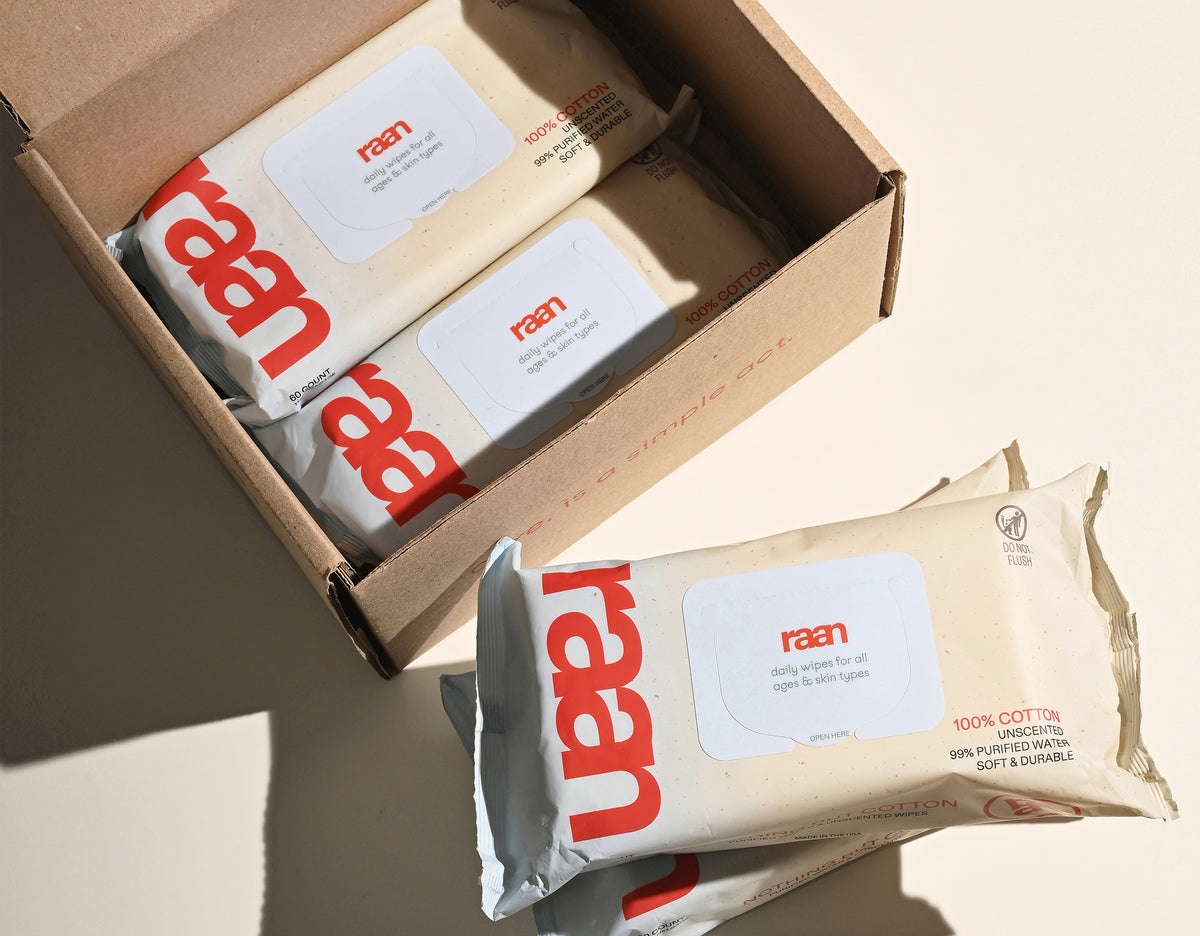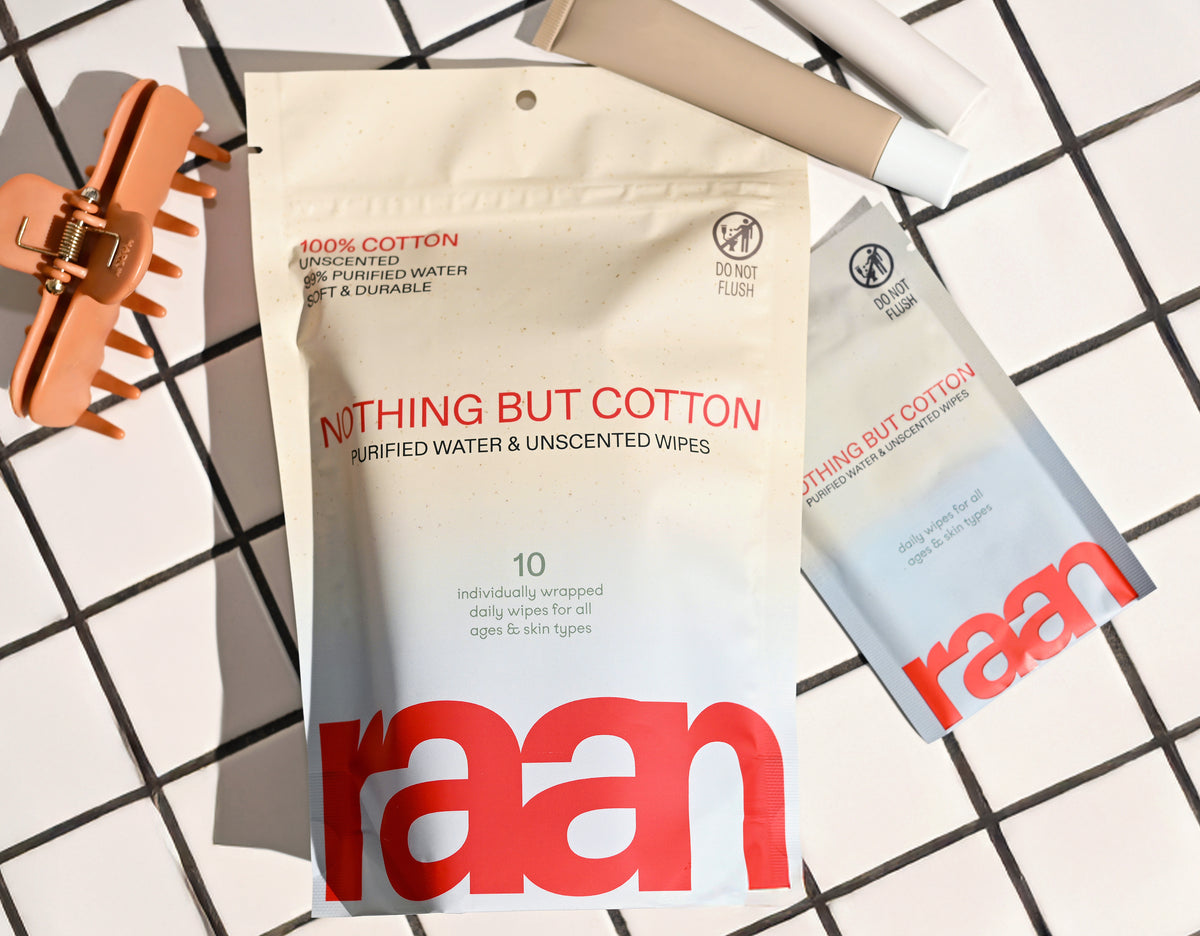Key Takeaways
- The best wipes for newborns are made with unbleached, 100% cotton and contain only five EWG-verified ingredients.
- Safe wipes avoid plastic fibers, synthetic preservatives, and numerous additives commonly found in conventional wipes.
- Prioritizing simplicity in wipe formulations is more important than attractive packaging or bold marketing claims.
Table of Contents
- What Makes a Wipe Truly the "Best" for Newborns?
- Ingredient Deep Dive: What to Look for, and What to Avoid
- How to Choose Wipes for Your Newborn: The Step-by-Step Process
- Wipe Types Explained: Water-Based, Biodegradable, Scented, and Unscented
- What Really Matters for Newborn Skin: Hypoallergenic, Dermatologist-Tested, and Beyond
- Sensitive Skin? How to Prevent and Handle Wipe-Related Irritation
Best Wipes for Newborns: A Clear, Science-Backed Guide for Everyday Use
The best wipes for newborns aren't the ones with the prettiest packaging or the boldest marketing claims, they're the ones made with unbleached, 100% cotton and just five EWG-verified ingredients. While most conventional wipes contain plastic fibers, synthetic preservatives, and a laundry list of additives, truly safe wipes prioritize simplicity over flashy formulations.
After years of navigating misleading "clean" claims in the baby care aisle, we've learned that the safest choice for newborn skin is often the most straightforward one. Real transparency means knowing exactly what touches your baby's skin, from the cotton material to every single ingredient in the formula. For parents on the go, individually wrapped cotton wipes offer a convenient, mess-free solution for sensitive skin.
What Makes a Wipe Truly the "Best" for Newborns?
The "best" wipe for newborns delivers gentle effectiveness without compromise. This means materials that won't irritate delicate skin, ingredients you can pronounce and trust, and performance that handles real-life messes, from 3 AM diaper changes to sticky fingers after feeding time.
Newborn skin is 40% thinner than adult skin, making it more permeable to whatever we put on it. The best wipes acknowledge this vulnerability with deliberate material choices: unbleached cotton instead of plastic blends, purified water instead of tap water, and food-grade preservatives instead of synthetic alternatives.
Essential criteria for newborn wipes:
- Material integrity: 100% cotton, unbleached and free from plastic fibers
- Ingredient transparency: Five or fewer components, all EWG-verified
- Functional design: Adequate moisture and thickness for effective cleaning
- Trusted certifications: Hypoallergenic, dermatologist-tested, cruelty-free
- Sustainable packaging: Minimal plastic use, recyclable materials
Ingredient Deep Dive: What to Look for, and What to Avoid

The safest wipes for newborns contain ingredients you'd feel comfortable putting in your mouth, because everything that touches baby's skin gets absorbed to some degree. The gold standard includes purified water (for gentle moisture), organic aloe (for skin conditioning), and food-grade preservatives like sodium benzoate and potassium sorbate.
Each ingredient should serve a clear purpose. Purified water provides the cleaning power without harsh chemicals. Organic aloe soothes and moisturizes naturally. Ethylhexylglycerin acts as a gentle skin conditioner. Citric acid balances pH to match your baby's natural skin chemistry.
| Ingredient | Function | Safety Notes |
|---|---|---|
| Purified Water | Primary cleanser, 99% of formula | Removes impurities found in tap water |
| Organic Aloe | Natural moisturizer and soother | Anti-inflammatory properties, gentle on sensitive skin |
| Sodium Benzoate | Food-grade preservative | Prevents harmful bacteria growth, used in baby food |
| Potassium Sorbate | Food-grade preservative | Natural antimicrobial, safe for daily use |
| Ethylhexylglycerin | Skin conditioning agent | Derived from glycerin, enhances skin feel |
| Citric Acid | pH balance | Maintains optimal skin pH, naturally derived |
Ingredients to avoid on newborn skin: Alcohol (drying and irritating), parabens (hormone disruptors), phthalates (linked to developmental issues), synthetic fragrances (common allergens), and plastic fibers (microplastic concerns). For more on what to avoid and why, see this best wipes for sensitive skin resource.
How to Choose Wipes for Your Newborn: The Step-by-Step Process
Step 1: Scan the ingredient list. Look for five or fewer components, all clearly identified. If you see "fragrance" or "parfum" without specification, that could represent dozens of undisclosed chemicals.
Step 2: Check the material composition. The wipe itself should be 100% cotton, unbleached. Avoid anything listing "polyester blend" or "non-woven fabric", these contain plastic fibers that can irritate sensitive skin.
Step 3: Test cautiously. Use one wipe on a small area of your baby's leg and observe for 12-24 hours. Look for any signs of redness or irritation before using more widely. This simple patch test helps ensure your baby's skin tolerates the formula.
Wipe Types Explained: Water-Based, Biodegradable, Scented, and Unscented
Water-based wipes contain 99% water with minimal additives, making them ideal for newborns with ultra-sensitive skin. These wipes clean effectively without overwhelming delicate skin barriers with unnecessary chemicals. They're particularly valuable during the first few weeks when your baby's skin is still adapting to life outside the womb. If you need a larger supply for home and travel, the mess-ready pack offers a convenient, eco-friendly option.
Biodegradable wipes break down naturally after disposal, typically within 6-8 weeks in commercial composting facilities. Made from materials like unbleached cotton or bamboo, they reduce environmental impact while maintaining cleaning effectiveness. However, check that biodegradable doesn't mean compromised durability, you still need wipes that won't tear mid-cleanup.
Scented vs. unscented presents a clear choice for newborns: always choose unscented. Fragrances, even "natural" ones, can trigger skin reactions in babies whose protective barriers are still developing. Unscented wipes let you focus on cleaning without introducing potential irritants.
| Type | Key Traits | Best For | Watch Out For |
|---|---|---|---|
| Water-Based | 99% water, minimal ingredients | Ultra-sensitive newborn skin | May dry out faster once opened |
| Biodegradable | Natural fibers, compostable | Eco-conscious families | Verify strength and moisture retention |
| Unscented | No added fragrances | All newborns (recommended) |
None, this should be standard |
What Really Matters for Newborn Skin: Hypoallergenic, Dermatologist-Tested, and Beyond

Hypoallergenic means the product is formulated to minimize allergic reactions, but it's not a regulated term. Look for specific certifications like EWG Verified, which requires rigorous ingredient screening against known allergens and irritants. This certification process evaluates every ingredient for safety concerns, giving you concrete assurance rather than marketing claims.
Newborn skin is up to 30% thinner than adult skin, with a higher pH that makes it more permeable to both beneficial and harmful substances. This means everything you put on your baby's skin gets absorbed more readily. The best wipes for newborns acknowledge this reality with ultra-gentle formulations that respect these physiological differences. For more research on baby skin permeability and product safety, see this scientific review on infant skin barrier function.
Dermatologist-tested indicates the product has undergone professional evaluation for skin safety, but ask what specific testing was done. Patch testing on adult volunteers differs significantly from studies on infant skin. Look for products that specify testing protocols and provide transparent results rather than vague claims.
Trusted Certifications to Look For: EWG Verified (comprehensive ingredient screening), Natural Cotton Seal (material purity), Cruelty Free (ethical testing), Made in USA (manufacturing standards).
For additional insights on choosing the right wipes for delicate skin, you may find this best wipes for delicate skin care article helpful.
Sensitive Skin? How to Prevent and Handle Wipe-Related Irritation
Prevention starts with ingredient awareness. Avoid wipes containing alcohol, parabens, phthalates, or synthetic fragrances, all common triggers for sensitive skin reactions. Instead, choose wipes with food-grade preservatives and skin-conditioning ingredients like organic aloe that actively support skin health. For more on safety issues and best practices, refer to this external guide on baby wet wipes safety.
If irritation appears (redness, bumps, or unusual dryness), immediately switch to plain water and soft cotton cloths for cleaning. Allow the affected area to air dry completely between changes, and avoid applying any new products until the irritation subsides. Most wipe-related reactions resolve within 24-48 hours once the irritant is removed.
For persistent issues lasting more than three days, or if you notice spreading redness, open sores, or signs of infection, contact your pediatrician. Document which wipes you were using and when symptoms started, this information helps healthcare providers identify specific triggers and recommend appropriate alternatives. For families who need a portable solution for outings, individually wrapped cotton wipes are a gentle and convenient choice.
Frequently Asked Questions
What ingredients should I look for in the best wipes for newborns to ensure they are safe and gentle?
Look for wipes with a minimal formula, ideally five or fewer ingredients, that are all EWG-verified. Key components include purified water, food-grade preservatives like sodium benzoate and potassium sorbate, organic aloe for moisture, ethylhexylglycerin for skin conditioning, and citric acid to balance pH. This simplicity reduces the risk of irritation and keeps your newborn’s skin safe.
Why is it important to choose wipes made from unbleached, 100% cotton rather than conventional wipes with plastic fibers?
Newborn skin is delicate and more permeable, so avoiding plastic fibers means fewer irritants and less exposure to microplastics. Unbleached, 100% cotton preserves the natural softness and breathability of the material, offering a gentler, safer touch that supports healthy skin without unnecessary additives or synthetic fibers.
How can I identify wipes that are truly hypoallergenic and dermatologist-tested for sensitive newborn skin?
Look for clear, transparent labeling backed by credible certifications like EWG Verified and dermatologist testing. True hypoallergenic wipes avoid fragrances, synthetic preservatives, and harsh chemicals, focusing instead on simple, well-studied ingredients. Trust comes from brands that openly share their ingredient list and testing processes without vague claims.
What are the benefits of using wipes with minimal ingredients and EWG-verified components for my newborn?
Minimal, EWG-verified ingredients mean fewer chances of irritation or allergic reactions, making wipes safer for sensitive newborn skin. This transparency gives you peace of mind, knowing exactly what touches your baby’s skin. Plus, simpler formulas often perform better by focusing on essential functions, cleaning and moisturizing, without unnecessary extras.






